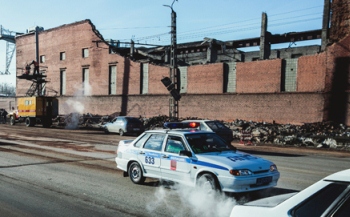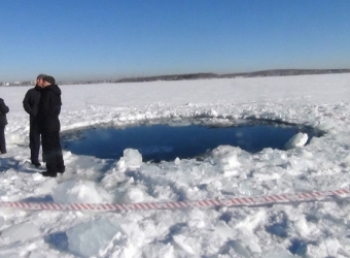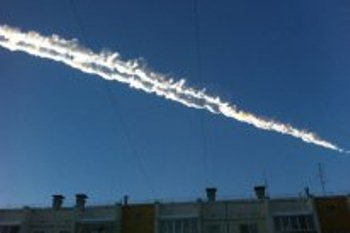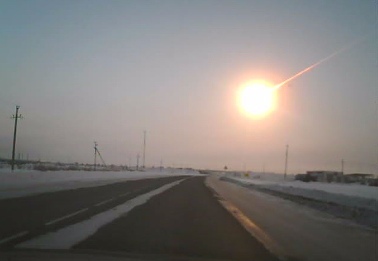 It has been more than a month since the fall of the fireball in the Urals, however, up to now, its mysteries have not been dissipated and scientific society has been very vague on this point. According to the media, on 15 February 2013, at 09:23 a.m. local time (07:23 MSK), the meteorite entered the Earth’s atmosphere over the city of Chelyabinsk and exploded. The «Chelyabinsk meteorite» aroused heated discussion not only in the Russian media but also in the foreign press and social networks. According to experts, this phenomenon happens once in a hundred years.
It has been more than a month since the fall of the fireball in the Urals, however, up to now, its mysteries have not been dissipated and scientific society has been very vague on this point. According to the media, on 15 February 2013, at 09:23 a.m. local time (07:23 MSK), the meteorite entered the Earth’s atmosphere over the city of Chelyabinsk and exploded. The «Chelyabinsk meteorite» aroused heated discussion not only in the Russian media but also in the foreign press and social networks. According to experts, this phenomenon happens once in a hundred years.
Falling celestial body chronicle
 The fall of the «meteorite» in the Urals affected residents of the Tyumen, Kurgan, Sverdlovsk regions and also northern Kazakhstan. But just in the Chelyabinsk region there are most of the damaged buildings – the shock wave blew glass from windows. According to city officials, there were about 170,000 meters square of window glass to be replaced in the Chelyabinsk region, an estimated 100,000 meters square of which were in the city of Chelyabinsk. There were damaged around 3,000 buildings, including 34 healthcare institutions, 11 establishments of social protection, 361 schools and kindergartens in the Chelyabinsk region. A zinc factory in Chelyabinsk was damaged by the blast, which blew a hole in its walls, but the plant was operating as usual, as well as other industrial facilities in the city. According to the Emergency Situations Ministry, more than 1,000 people were injured and around 50 were hospitalized, mostly for cuts from broken glass from windows that were blown in when the shock wave arrived. It was only by good fortune that there were no fatalities.
The fall of the «meteorite» in the Urals affected residents of the Tyumen, Kurgan, Sverdlovsk regions and also northern Kazakhstan. But just in the Chelyabinsk region there are most of the damaged buildings – the shock wave blew glass from windows. According to city officials, there were about 170,000 meters square of window glass to be replaced in the Chelyabinsk region, an estimated 100,000 meters square of which were in the city of Chelyabinsk. There were damaged around 3,000 buildings, including 34 healthcare institutions, 11 establishments of social protection, 361 schools and kindergartens in the Chelyabinsk region. A zinc factory in Chelyabinsk was damaged by the blast, which blew a hole in its walls, but the plant was operating as usual, as well as other industrial facilities in the city. According to the Emergency Situations Ministry, more than 1,000 people were injured and around 50 were hospitalized, mostly for cuts from broken glass from windows that were blown in when the shock wave arrived. It was only by good fortune that there were no fatalities.
According to official data, background radiation levels in Chelyabinsk were in normal range, but people complained about ear congestion and headache. Local residents believe that on 15 February and in the following days the sun was extremely bright, more dazzling than usual. As a result of the explosion, the ozone hole was formed in the region, reported Газета.ру. At the local zoo brown bears woke up from hibernation because of the falling bolide crash, and the night air in the neighborhood was filled with wolves howling..
According to NASA, the meteorite released 300 up 500 kilotons of energy at the moment of entry in the atmosphere over the Chelyabinsk region, reported Associated Press. It’s a force 20 times more powerful than was released from the atomic bomb detonated at Hiroshima. With an estimated initial mass of 10,000 tonnes and approximately 17 metres across, the Chelyabinsk meteor entered Earth’s atmosphere at a hypersonic speed at least 64,000 km per hour and shattered in pieces about 19 to 24 kilometres high. This was published on the NASA website. However, the NASA data about Chelyabinsk meteorite differ from those given by the Russian Academy of Sciences. According to Russian experts, the meteorite entered the atmosphere at a speed of 54,000 km per hour and exploded at an altitude of 30-50 km. Before falling to Earth, the fireball exploded 9 times, starting at an altitude of about 55 km and left a trail 480 km long.
According to experts, the Russian «meteorite» was the largest reported since 1908, when a meteor hit Tunguska, Siberia. The object was brighter than the Sun and its trail could be observed for about 30 seconds. At 12:00 MSK February 15 it was reported some «meteorite» fragments fell in a reservoir outside the town of Chebarkul, 80 km from Chelyabinsk. There was the 8-metre-wide crater in Lake Chebarkul’ frozen surface, 1,5 km from the coast. Scientists thought that the largest meteorite fragment fell in the lake just here.
However, according the information, coming from official sources, there have not been discovered meteoritic fragments anywhere in the region so far despite 20,000 rescuers and recovery workers, 8 units of air transport, 4,500 units of ground transport had been dispatched to the region. World scientists still cannot clearly define the nature of the object exploding or causing an explosion over Chelyabinsk. There is used the term «presumably a meteorite» in the reports of Russian Emergency Ministry and NASA, and a different formulation – UFOs in the statement of Roshydromet.


Fireballs – Supreme Powers Work
The point is that for a few days in the month of February there have been seen some falling and exploding fireballs in many countries of the world as: Russia, Kazakhstan, Japan, Australia, Cuba, South Africa, Morocco, Germany, Switzerland, northern Italy, the Netherland, Belgium, Britain. The huge size of the fireball was observed by many witnesses over Belgium, Holland, and Germany on 13 February 2013. It can be seen for 10-20 seconds. Exploding fireball was also observed in the skies over Japan on 14 February and filmed by. In the late afternoon of February 15 the Cuban people noticed another bright fireball that exploded over the city in the province Sienfuego. And on 22 March 2013 many Americans were greatly frightened by a falling fireball that they saw in the eastern U.S. sky.
 In order to get the gist of the space attack on Earth we asked Bio-energy specialist Galiya Kazhgaliyevna Kerey to comment on these phenomena. She says: «According to Supreme Powers, the fireball in the Urals is not a meteorite. It was a Work arranged by Supreme Powers to close the negative zone on Earth. The fireball is a clot of light energy; that is why it left a white trail. There will not be found any stone, there are no remains of this Work – do not look for anything. By means of fireball Supreme Powers remove barriers to change the Earth. For this reason the fireballs were seen in many parts of our planet – the Earth is being purified. No matter in what form it will occur: someone sees a sphere, someone sees a tail, other – flashes. In the near future this work (as over Chelyabinsk) will repeat in the southeastern part of the Earth».
In order to get the gist of the space attack on Earth we asked Bio-energy specialist Galiya Kazhgaliyevna Kerey to comment on these phenomena. She says: «According to Supreme Powers, the fireball in the Urals is not a meteorite. It was a Work arranged by Supreme Powers to close the negative zone on Earth. The fireball is a clot of light energy; that is why it left a white trail. There will not be found any stone, there are no remains of this Work – do not look for anything. By means of fireball Supreme Powers remove barriers to change the Earth. For this reason the fireballs were seen in many parts of our planet – the Earth is being purified. No matter in what form it will occur: someone sees a sphere, someone sees a tail, other – flashes. In the near future this work (as over Chelyabinsk) will repeat in the southeastern part of the Earth».
Not without reason the Ural region is «well known» worldwide for its anomalous zones and phenomena – it is really negative zone. That is why various strange phenomena happen in these places: meetings with humanoids, unexpected fires, flying objects, disappearances of people, etc. There has been even created a map of anomalous zones of the Urals that includes more than 50 points in the Tyumen, Kurgan, Chelyabinsk and Sverdlovsk regions, Perm Krai and the Republic of Bashkortostan. It is just the area that known for the plane with 13 passengers that have been disappeared and not found since 2010 or for the death of 9 students – skiers found «pulled to pieces» in the 50s and many other phenomena.
Since 2010 the «earthquakes», allegedly caused by recycling of old ammunition on Chebarkul range, have occurred in Chelyabinsk and the nearest inhabited localities. Ever since, residents of the region constantly complain of tremors, shaking houses and blast which reach them from the range. The «trembling Earth» was recorded even by the seismic station «Arti», located in the Sverdlovsk region. The Chelyabinsk authorities repeatedly made attempts to resolve the conflict with the Ministry of Defense. But the most surprising «anomaly» is the reaction of the government of the Russian Federation, in particular of the Ministry of Defense, on the space attack in the Urals. Unscheduled military tactical training of airborne troops started on 20 February 2013, on the Chebarkul training range. The action involved about 7.000 troops, several hundred pieces of military equipment, and about forty aircrafts for various purposes. This is the Russian response to the «Chelyabinsk meteorite». After the unexpected fireball, at a speed 40-60 times greater than the speed of sound, burst over the Urals Mountains and rained down with bright flashes, the Russian military said it will develop a technology for the destruction of such objects before they reach the Earth.
Dastan Eldesov
March 25, 2013
